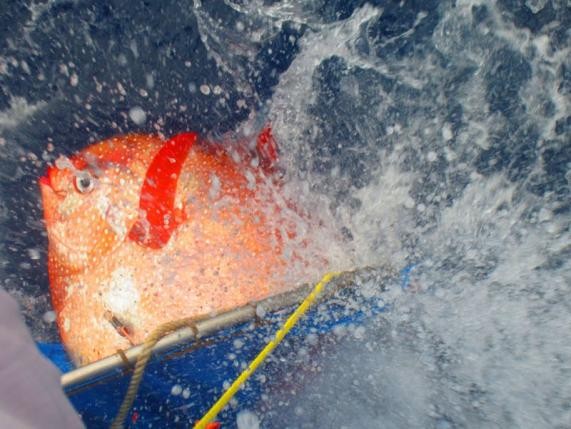A biologist has accidentally discovered the first "truly" warm-blooded fish. The fast-swimming opah fish is two meters (6.5 feet) long, and looks like a huge puffy disc with tiny fins.
The opah's color is a rust-red, while its body includes white spots and bright red fins. It weighs up to 90 kg (200 pounds), and is around a car tire's size.
A fish's overall body temperature usually equals the water temperature in which it swims. Some fish species can warm parts of their bodies, but are not classified as warm-blooded animals, or endotherms.
However, the opah is unique as it can warm its entire body about 4-5 degrees Celsius (9 degrees Fahrenheit) higher than its environment, according to NBC News. It even heats up its brain and heart.
Nicholas Wegner, a biologist at the National Oceanic and Atmospheric Administration (NOAA), discovered the opah by accident during a research trip.
While dissecting the odd-looking fish, Wegner observed that the gills included retia mirabilia, red and blue blood vessels.
Sharks and tuna use the same blood vessels to warm sections of their bodies. However, the opah's multi-colored blood vessels were contained in the fish gills, rather than its swimming muscles.
When the opah flaps its wing-like pectoral fins to create heat, warm blood travels throughout its entire body before water in the gills cools it. However, the body's oxygen-poor warm blood heats the oxygen-rich blood in the opah's gills.
The result is that the cold blood stays in the gills. Other parts of the first fully warm-blooded fish, such as its heart, brain, and muscles, never heat up.
The warm-blooded opah has an edge over its cold-blooded prey, or ectotherms. Its advantages include quicker swimming speeds, faster reaction times, and superior eyes and brains.
Wegner explained that despite its huge size and disc shape, the fish is an extremely fast swimmer and an "active predator," according to The Verge. Opah fish swim thousands of kilometers to migrate.
The discovery of the first true warm blooded fish was published Thursday in the journal Science.




























